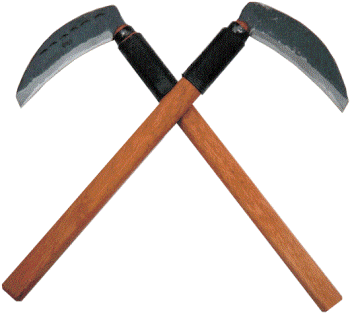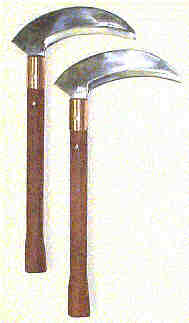Kama
The kama is an agricultural sickle and many were certainly
imported from China for the farming classes. It has a long wooden handle
and a thin razor-sharp curved blade at one end. It makes a formidable
weapon even against the most determined enemy. Used in pairs they were
flexibly reversed in the hand for both slashing and striking in a great
many directions
. 
If, however, the modern sickle resembles the ones used by the feudal
farming class, it is apparent that one single blocking technique would
sever the blade from the shaft and make it useless. (The Shureido kama,
above, has blades 3/16" thick and sturdy red oak shafts to withstand the
rigors of kobudo. The shafts have been wrapped where they come in contact
with other weapons. It is, however, very heavy to use and requires consistent
training to strengthen one's hands and avoid flying, sharpened kama!)
Once again it is probable that more sturdy kama were constructed for fighting
- although farming ones were no doubt also used.
The techniques of this weapon are not often seen in modern times and
there are only two registered kata in Japan today, called Kanigawa and
Tozan. Kata with this weapon, like the sai or tonfa, usually assumes that
you will have one in each hand. And any time you work with two weapons
you run a greater risk of accident than when you need control only one.
Your mind must be in two places at once, divided between two objects.
Then there is the fact that the kama is sharp-edged, able to cut a serious
gash in the human body when swung with maximum force and speed. 
In addition, most skilled practitioners consider it a point of honor to use live blades in big martial arts demos, when their skill is being displayed. Some like Ota even train with the razor-sharp blades exposed. Losing control for a split second can mean injury, even death. And third, though this is an advanced stage of training, in many techniques only one kama is kept in the hand- the other is swung by a rope, wrapped about the body, twirled around behind the head, the neck, the waist. The combat origin of this last aspect of training is fairly simple. No matter how skilled, the karateka can only look in one direction at a time. The kama whirling behind him helps to cover his rear against attack. He can dispatch the enemy in front with one weapon, while the dangerous and unpredictable wrapping, whirling movements of the other help keep a second assailant at bay.